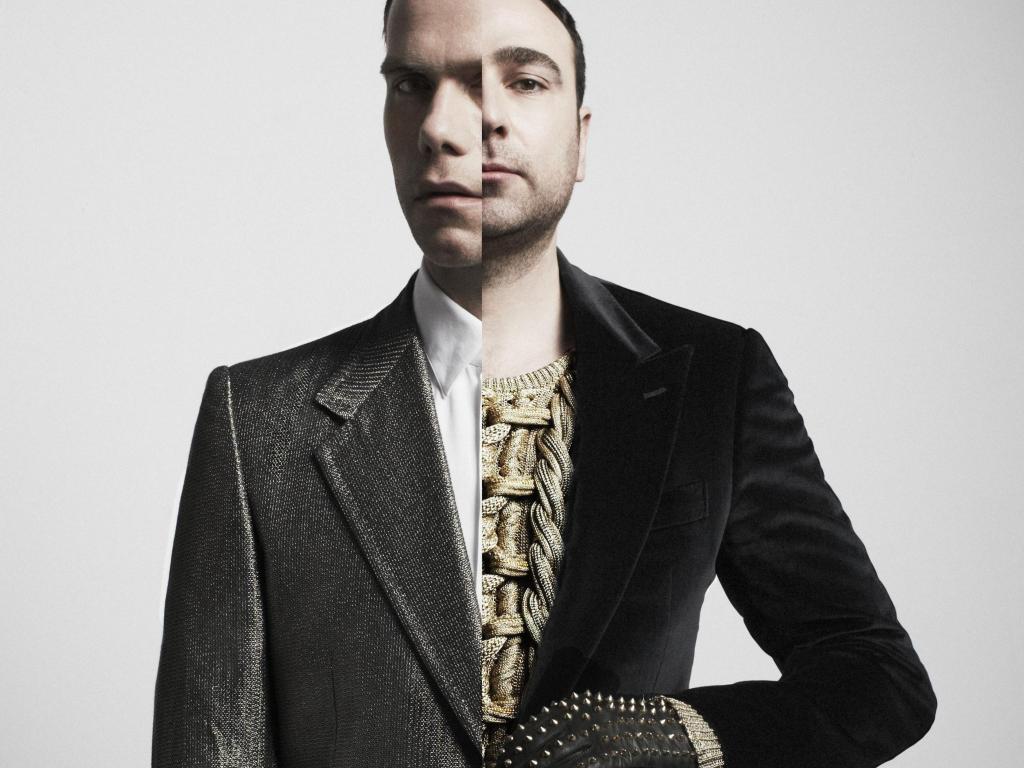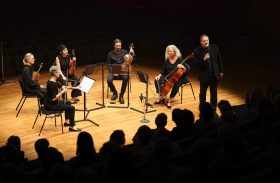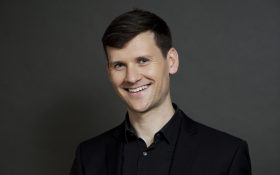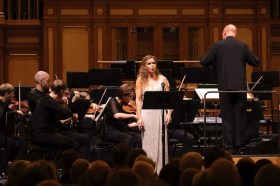The Presets. Image by Jordan Graham.
Entitled Timeline, the latest offering from the Australian Chamber Orchestra purported to cover the past 42,000 years of music. The regular subscriber might be a tad perturbed by this proposition because, dear reader, there is no seat in the universe that would be comfortable enough to sit on through all of that. Nor, indeed, a human lifespan long enough to bridge it. Instead we were treated to a highlights package, as it were.
Joining the usual orchestra, too, were The Presets, helping them to mix things up and coming more to the fore as the millennia rolled by towards us. And, to top it all off, above the City Recital Hall platform hung a large screen on which were projected a constant stream of images throughout the night.
We began with The Sound of the Big Bang: Planck version by John Gleason Cramer. It was not, much to this critic’s disappointment, a recording from around 13.8 billion years ago. It was basically a cacophony of white noise, both for the ear and for the eye, and it gave way to the proper start of humanity’s music, an Improvisation on Didgeridoo by Mark Atkins, circa 40,000 BC. This in turn gave way to some more Indigenous music, which itself lead on to drumming from Ancient China, circa 5,000 BC. After a foray into Ghana, Greece, Persia, and a few others, we settled to a more leisurely trot once we hit the Gregorian chant of Lux fulgebit in 750 AD. And so was set the pattern for the rest of the concert, with the pieces being quickly brought up then dispatched just as speedily. The first half of the concert was devoted to the more classical era of, for all intents and purposes, Western music (Big Bang – 1900), while the second was split into three, although there was no discernible break between them, spanning 1900 – 2014 and beyond.
There are, obviously, some strengths and weaknesses that become evident when such an ever-accelerating system is applied to music – one never gets to hear as much of a piece as one would like, for instance. For example, the ACO gave a stunning string-arranged rendition of Wagner’s Tristan und Isolde: Prelude to Act 1, that was cut brutally short to make way for Brahms’ Geistliches Lied. Thankfully, for those fortunate enough to see subsets of the ACO in chamber concerts at Pier 2/3 last year, we had already been treated to it one and a half times. At other times, the pieces were mushed together one on top of the other, moreso in the 20th century, but also in the classical era, such as when Beethoven’s ninth symphony was reduced to just the double bass, cellos, and violas playing the ode to joy theme while a traditional African American field call was played over the top. Arnold Schoenberg’s ‘Verklarte Nacht’ – Transfigured Night – was the last piece before the interval, ending with a shattering of glass animated both aurally and visually. The 20th century had arrived, ready to ruin and remake it all for better or worse.
Popular music was the defining feature afterwards, though there was still plenty of ‘classical’ music as well. Centre stage was a ye olde amplifier/speaker, tinnyfying the voice of any singer – such as violinist Satu Vanska, or some of the six-member choir – during renditions of such hits as Duke Ellington’s It Don’t Mean a Thing (If It Ain’t Got That Swing). Miles Davis tunes from the trumpeter also stood out against the rest for their yearning lyrical power, and this critic is happy to say that he has finally had the opportunity – even if it was an abridged one – to hear John Cage’s famous 4’33”, where Tognetti flourished his bow and the orchestra readied to play, and then froze in silence for the next minute. There was, perhaps, a little too much sampling of the pop songs (where the audience was listening to a recording only), but this critic, as mildly unsatisfied with it as he was, cannot see another feasible way that it could have been done.
From Elvis Presley to Bob Dylan to The Ronettes to The Beach Boys to James Brown to Bob Marley to Michael Jackson to Bjork to Daft Punk to Eminem to Britney Spears to Kanye West to Lady Gaga to Psy (and his Gangnam Style), we were treated to a panoply of styles and progressions, whirring by faster and faster until a beautiful blur. Phillip Glass, Vangelis, and Steve Reich also get mentions, as well as Brian Eno, Pierre Boulez, Alban Berg, and Samuel Barber, among many others.
Once 2000 was reached, the ACO was rendered irrelevant by their onstage illumination being withdrawn, with all eyes on The Presets for a masterful mix-up of the last 14 years in music. The animations, too, improved on an already good showing previously. Instead of the more slow and representative religious, warlike, and industrial images depicting a pseudo-rise of mankind, we were treated now to abstract and rapidly moving visualisations that fitted the music to a tee
It ended, however, with the world premiere of a composition by Tognetti and The Presets entitled ‘Continuum.’ It wasn’t so much a chaotic summation of all that came before, but rather a surprisingly gentle reflection on things past, present and future, finishing once again in the white noise of the universe. Not, perhaps, the best standalone piece, but it tied the loose ends of the concert up extremely well, solving the problem that would have been if a single pop song had to be chosen as the last sound of history so far.
What this concert showed with great success was the circularity of our music, as well as the call and response of humanity across the eons, in a way that was both poignant and enlivening. It’s not the best thing the ACO has ever done – indeed, the higher emotions weren’t tapped quite as much as they may have been if a piece had been played in its entirety in isolation, but this critic can’t imagine the concept of this show being performed any better. It works, and extremely well at that, and anyone with an interest in music should get a ticket post-haste.
Rating: 4 ½ out of 5 stars
Timeline: Life Flashes Before Your Ears
Australian Chamber Orchestra
Artistic Director and Violin: Richard Tognetti
Director: Ignatius Jones
Vocal Director: Graham Ross
With The Presets
City Recital Hall, Angel Place
www.aco.com.au
19 May – 4 June





